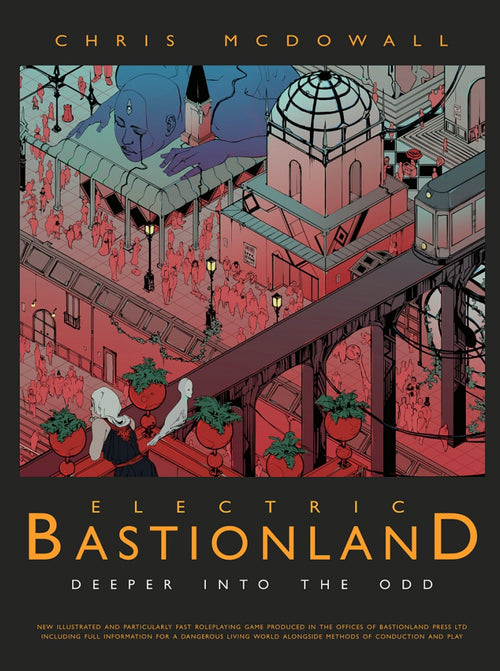Into the Odd Fantasy; Dark Fantasy; Bleak; Exploration-Driven; Rules Lite; New School Revolution (NSR)
Into the Odd is a rules-light, New School Revolution (NSR) tabletop roleplaying game emphasizing exploration, player ingenuity, and a grim, industrial-fantasy setting. Its streamlined mechanics prioritize player choices and consequences over dice rolls, creating a fast-paced and deadly gaming experience. The game is designed to be easily accessible, quick to learn, and adaptable, making it suitable for both experienced roleplayers and newcomers seeking a different kind of fantasy adventure. The setting revolves around Bastion, a smoke-shrouded industrial hub surrounded by a world of cosmic horror and strange occurrences, ripe for exploration and discovery.
Theme and Setting
Into the Odd plunges players into a dark and strange industrial age setting reminiscent of a blend between Victorian London and cosmic horror. Bastion, the primary city, serves as a hub of industry and the last bastion of mankind, surrounded by dangerous and unexplored territories. The world is filled with lurking horrors, bizarre creatures, and the remnants of arcane technologies known as Arcana. Explorers venture into these uncharted lands seeking riches and powerful artifacts, facing constant threats and uncovering unsettling truths.
The game evokes a strong sense of dread and mystery. The world is not a safe or predictable place. Expeditions often lead to encounters with horrific creatures and mind-bending phenomena. The overall theme is one of survival and discovery in a world that is both wondrous and terrifying.
Core Mechanics and Rules
Into the Odd's core mechanics are exceptionally streamlined and rules-light. Character creation is remarkably fast, involving rolling for three ability scores (Strength, Dexterity, and Willpower) and hit points, followed by randomly determining starting equipment and a potential unique trait based on stat values. There are no skills or character classes, encouraging players to rely on their creativity and resourcefulness.
The game uses a simplified roll-under system for saves. Players roll a d20 and must roll equal to or under their relevant ability score to succeed. Combat is fast and deadly, with attacks always hitting. Damage is determined by the weapon used and is deducted from hit points. Once hit points are depleted, damage is applied to the Strength score. Taking Strength damage requires a Strength save to avoid critical injuries. A short rest restores Hit Points, while restoring ability score damage requires a full week of rest.
One of the most intriguing aspects of the game is its approach to challenges and traps. Instead of relying on perception checks, the game encourages GMs to present obstacles as 'Consequence or Danger' scenarios. Players are assumed to notice traps unless impaired, and the focus shifts to how they react and overcome the hazard. This promotes player agency and creative problem-solving.
What Makes It Unique
Several factors contribute to Into the Odd's unique appeal:
- Rules-Light Simplicity: The game's minimalist ruleset makes it easy to learn and quick to play, focusing on player decisions and GM rulings rather than complex mechanics.
- Deadly Combat: The certainty of hits and the limited hit points create a tense and dangerous combat environment where smart tactics and resource management are crucial for survival.
- Arcana: The presence of strange, powerful artifacts known as Arcana introduces an element of wonder and unpredictability. These items can be used in creative ways, adding depth and intrigue to the gameplay.
- Emphasis on Exploration: The game encourages exploration and discovery, rewarding players who venture into the unknown and uncover the secrets of the Odd World.
- The Oddpendium: The inclusion of the Oddpendium, a collection of generators and tables for creating unique NPCs, locations, and events, further enhances the game's replayability and facilitates worldbuilding. The Oddpendium provides a great foundation for improvisation and fleshing out the world.
These elements combine to create a distinctive and memorable gaming experience that sets Into the Odd apart from more traditional fantasy RPGs.
Target Audience and Player Experience
Into the Odd appeals to players who enjoy:
- Old-School Roleplaying: The game embraces the OSR ethos of player agency, challenging gameplay, and GM rulings.
- Rules-Light Systems: Players who prefer streamlined mechanics and a focus on narrative and character interaction will find Into the Odd appealing.
- Dark Fantasy Settings: The game's grim and unsettling world, with its blend of industrial horror and cosmic strangeness, will resonate with fans of dark fantasy.
- Exploration-Driven Games: Players who enjoy exploring dangerous and mysterious environments will appreciate the game's emphasis on discovery.
- High-Mortality Games: The deadly combat and perilous situations create a sense of risk and reward, where survival feels like a genuine accomplishment.
The player experience in Into the Odd is characterized by a sense of danger, wonder, and freedom. Players are encouraged to think creatively, take risks, and embrace the unpredictable nature of the game. The fast-paced combat and the constant threat of death keep players on their toes, while the intriguing setting and the powerful Arcana provide ample opportunities for adventure and discovery. The quick character creation allows for a high character turnover, which encourages experimentation and a focus on the overall story rather than individual character arcs. Some may find the lack of character customization initially off-putting, but this is quickly overcome by the need to use creativity to succeed.



